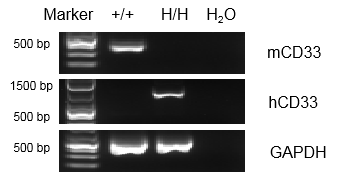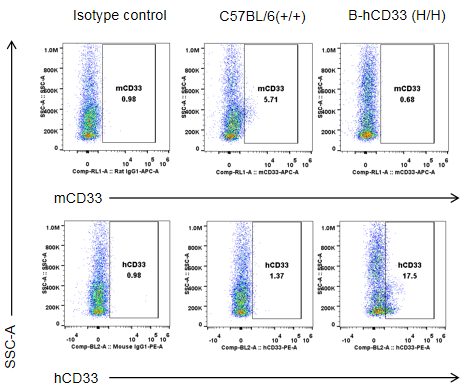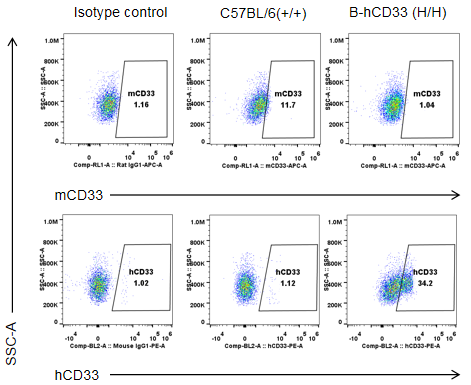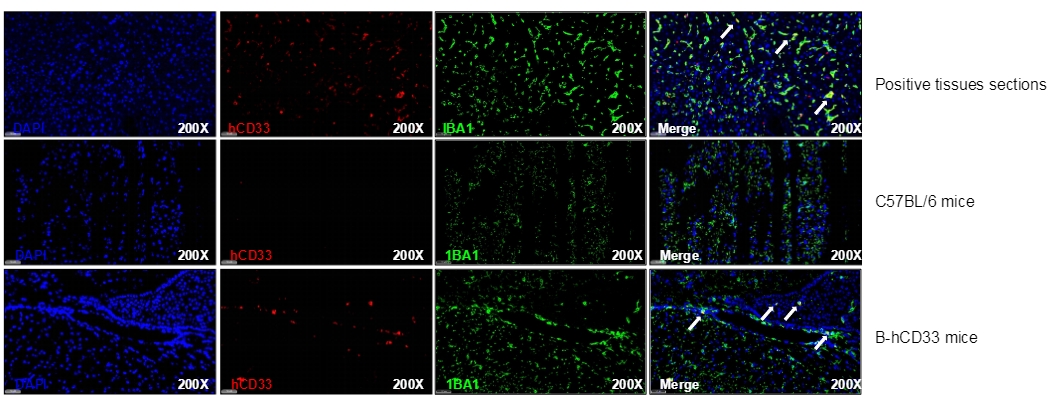


C57BL/6-Cd33tm1(CD33)Bcgen/Bcgen • 110823
| Product name | B-hCD33 mice |
|---|---|
| Catalog number | 110823 |
| Strain name | C57BL/6-Cd33tm1(CD33)Bcgen/Bcgen |
| Strain background | C57BL/6 |
| NCBI gene ID | 12489 (Human) |
| Aliases | SIGLEC-3, SIGLEC3, p67 |
CD33 or Siglec-3 (sialic acid binding Ig-like lectin 3, SIGLEC3, SIGLEC-3, gp67, p67) is a transmembrane receptor expressed on cells of myeloid lineage. It is usually considered myeloid-specific, but it can be found on some lymphoid cells. The extracellular portion of this receptor contains two immunoglobulin domains (one IgV and one IgC2 domain), placing CD33 within the immunoglobulin superfamily. The intracellular portion of CD33 contains immuno-receptor tyrosine-based inhibitory motifs (ITIMs) that are implicated in inhibition of cellular activity. As a member of the SIGLEC family of lectins, CD33 can be stimulated by any molecule with sialic acid residues such as glycoproteins or glycolipids (preferentially recognizes and binds alpha-2,3- and more avidly alpha-2,6-linked sialic acid-bearing glycans). Upon binding, the immunoreceptor tyrosine-based inhibition motif (ITIM) of CD33, present on the cytosolic portion of the protein, is phosphorylated and acts as a docking site for Src homology 2 (SH2) domain-containing proteins like SHP phosphatases. This results in a cascade that inhibits phagocytosis in the cell. CD33 is the target of gemtuzumab ozogamicin, an antibody-drug conjugate for the treatment of patients with acute myeloid leukemia, which was removed from the market in mid-2010 for a greater number of deaths, but was reintroduced to the market in 2017. Vadastuximab talirine (SGN-CD33A), a novel antibody-drug conjugate being developed by Seattle Genetics, utilizing this company’s ADC technology, is also targeted CD33.
Gene targeting strategy for B-hCD33 mice. The exons 1~3 of mouse Cd33 gene that the encode extracellular domain were replaced by human CD33 exons 1~3 in B-hCD33 mice.

Strain specific analysis of CD33 gene expression in wild-type mice and B-hCD33 mice by RT-PCR. Mouse CD33 mRNA was detectable in splenocytes of wild-type mice (+/+). Human CD33 mRNA was detectable only in homozygous B-hCD33 mice but not in wild-type mice.

Strain specific CD33 expression analysis in homozygous B-hCD33 mice by flow cytometry. Bone marrow cells were collected from wild-type mice (+/+) and homozygous B-hCD33 mice (H/H), and analyzed by flow cytometry with species-specific anti-CD33 antibody. Mouse CD33 was detectable in wild-type mice. Human CD33 was exclusively detectable in homozygous B-hCD33 but not in wild-type mice.

Strain specific CD33 expression analysis in homozygous B-hCD33 mice by flow cytometry. Bone marrow cells were collected from wild-type mice (+/+) and homozygous B-hCD33 mice (H/H), and analyzed by flow cytometry with species-specific anti-CD33 antibody. Mouse CD33 was detectable in wild-type mice. Human CD33 was exclusively detectable in homozygous B-hCD33 but not in wild-type mice.

Strain specific CD33 expression analysis in homozygous B-hCD33 mice by multiplex immunofluorescence staining. Brain tissue was collected from wild type C57BL/6 mice and homozygous B-hCD33 mice (female, 7-week-old) and processed into formalin-fixed paraffin-embedded tissue sections. The paraffin sections were immunolabeling using species-specific anti-human CD33 antibody (red) and the microglial marker IBA1 antibody (green). The results indicated that human CD33 is expressed in brain of B-hCD33 mice.